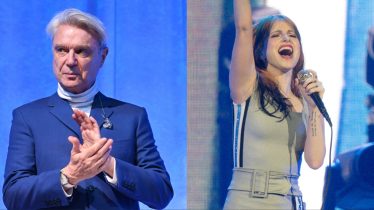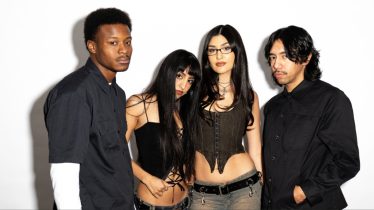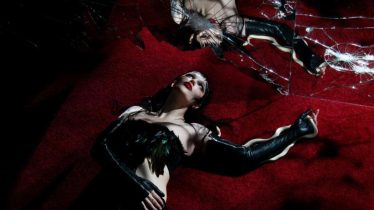These 15 punk albums of 1990 set the tone for the decade
Welcome to the best punk albums of 1990. True, the Sunset Strip glam metallers’ omnipresence seemingly denied punk ever happened. Oddly, the bands all wore shredded Sex Pistols or Ramones T-shirts, grasping for some sorta punk credibility. They’d never get it. That was more speed metal’s province. Yet, speed-metal kings Metallica, who continually cited punk acts such as Misfits as inspirations, couldn’t win 1989’s first-ever Hard Rock/Heavy Metal Grammy! They lost to flute-prog outfit Jethro Tull! Which is fine. When did the Recording Academy ever have street cred?
But the Berlin Wall crumbled. The USSR dissolved, ending a nearly century-long communist rule of Russia. Margaret Thatcher resigned from the British Prime Minister’s office. Playwright Lech Walesa (a huge Velvet Underground fan) became newly freed Poland’s President in a run-off election. And punk rock was still an underground force, about to burst free into the American mainstream.
Read more: These 10 punk singles from the ’70s didn’t need an LP to be great
Quickly peeking at the year 1990’s best punk albums reveals all the trends of the last year—and the decade to come—fully in place. The Didjits, Fastbacks, Lazy Cowgirls and Social Distortion releases displayed original 1977 punk sounds holding fast. Yet the latter’s rockabilly and country elements, alongside a new Cramps album and the Reverend Horton Heat‘s debut, show a strong roots-rock influence. Fugazi further refined their post-hardcore assault, while their staunchly indie business ethics served as an example for everyone. Poison Idea, the Dwarves and Leatherface all proved the continuing vitality of hardcore. The Gories and Thee Headcoats continued garage punk’s cultural incursion, foreshadowing the White Stripes and the Hives going mega one decade later. But Bad Religion and the debuts of Jawbreaker and some band called Green Day signposted the punk-pop invasion coming four years later.
One year hence, Nirvana‘s second LP changed everything forevermore. For now, these are the best punk albums of 1990.
Bad Religion – Against The Grain
Refine, refine, refine—this seemed to be the motto for Bad Religion on their fifth full-length. Their melodic hardcore was honed to razor keenness here. It boasted 17 songs in 35 minutes, the average length being 1:50. Virtually all except the midtempo “Faith Alone” and the original version of “21st Century (Digital Boy)” opened with a single snare crack from Pete Finestone and went ballistic from there. This must have worn on the drummer—he left in 1991, moving onto his side band the Fishermen. The album eventually sold over 100,000 copies, pushing them further into the mainstream spotlight.
Jawbreaker – Unfun
Meet another cornerstone of both the burgeoning punk-pop scene and the future emo outbreak. Singer/guitarist Blake Schwarzenbach and drummer Adam Pfahler grew up together in Santa Monica, California. They didn’t form what became Jawbreaker until moving to NYC to attend NYU and meeting bassist Chris Bauermeister. Eventually moving to Los Angeles, they tracked all 12 of Unfun’s songs in a two-day Radio Tokyo session in January 1990. Schwarzenbach’s ultra-crunchy guitar and sore-throat vocals (which still dripped melody like black honey) married the rhythm section’s penchant for instantly shifting, from 1978 pogo action to wildly Silly Putty-ed grooves.
Social Distortion – Social Distortion
Orange County’s stalwart trad-punk practitioners moved to the majors—specifically Columbia subsidiary Epic—for their third studio LP. Producer Dave Jerden sharpened the sonics. Mike Ness and Dennis Danell’s guitars got tighter and tougher. Ness’ vocals sounded more controlled. John Maurer’s fat bass cushioned Christopher Reece’s cracking drums. Social Distortion brimmed with plenty of vintage punk snarlers, such as openers “So Far Away” and “Let It Be Me.” But such country-influenced janglers as “Story Of My Life” and “Ball And Chain” became their first radio hits. An MTV now besotted with alt-rock embraced them, giving SD their first gold record.
Fugazi – Repeater
D.C.’s post-hardcore kings morphed in every way. Songwriting no longer sprang solely from singer/guitarist Ian MacKaye’s brow, emerging from collective jamming. Co-vocalist Guy Picciotto now shared guitar duties also. Taut blasters such as “Merchandise” percolated like MacKaye fronting a more hardcore Gang Of Four. Other tunes, including “Blueprint,” joined Pixies albums as a primer in whisper-to-scream dynamics. Many, such as Kurt Cobain, became eager pupils. Repeater eventually sold over 2 million, as Fugazi filled bigger and bigger halls, keeping tickets priced at $5. They also sold no merch nor granted interviews to magazines with liquor or tobacco advertising.
Green Day – 39/Smooth
The debut from the band who’d eventually properly plop punk into mainstream America’s consciousness was hardly Dookie. But many Green Day hallmarks were firmly there. Billie Joe Armstrong’s compact pop songs, dense guitar work and snarlingly melodious vocals? Check. Mike Dirnt’s meaty bass and French-kiss-close harmonies? Present. Tré Cool’s Keith Moon-in-miniature in drums? No, this is John Kiffmeyer’s record. Infectious rockers such as “At The Library” and “Green Day” hardly feature Dookie’s lush production. But the album’s still sonically cleaner and fuller than many of their Gilman Street colleagues’ efforts. Not an inauspicious debut, but hardly one of GD’s future world-beaters, either.
Poison Idea – Feel The Darkness
Out of Portland, all 1,300 pounds of the hard-living, hard-drinking Poison Idea had ripped and torn through the ’80s like a meth-stoked bull. Fronted by ferocious growler Jerry A. and the ballistic guitar of Tom “Pig Champion” Roberts, they were initially America’s hardest ’core outfit this side of Black Flag. Now boasting their most solid lineup, including genius drummer/producer Steve “Thee Slayer Hippy” Hanford, their third full-length was definitive PI Ballistic anthems such as “Taken By Surprise” and “Plastic Bomb” wed blisteringly savage punk/hardcore with catchy hard-rock dynamics. Poison Idea were now America’s answer to Motörhead.
Dwarves – Blood, Guts & Pussy
As Seattle’s Sub Pop Records gained a rightful reputation for issuing the most prime grunge, they also nursed a frequently overlooked, prodigious punk streak. These socially irresponsible miscreants from San Francisco by way of Chicago became the label’s most definitive punk act. The blatantly offensive sleeve boasted two young women and a proportionate male dwarf, all nude and covered in blood. The grooves spun out 11 ultra-raw slices of G.G. Allin-meets-Misfits offense-o-core, totaling 12:55. Yet, leading light Blag Dahlia ensured these one-minute scuzz blasts like “Fuck You Up And Get High” were melodious and solidly constructed. Blood, Guts & Pussy began a brilliant, sleazy legend. It should be on everybody’s best punk albums of 1990 list.
Leatherface – Fill Your Boots
Popcore, anyone? From the U.K. port city of Sunderland, Leatherface named themselves for the grisly Texas Chainsaw Massacre character. They answered the musical question no one thought to ask: “What if you crossed Motörhead with Hüsker Dü?” Be thankful they did. Their basic sonic character centered around a cracking rhythm section anchoring Frankie Stubbs’ and Dickie Hammond’s simultaneously raspy/jangly guitars, and Stubbs’ gravelly post-Lemmy vocals. This, their second LP, gained wider distribution for sturdy tunes such as “Razor Blades And Aspirin” and “Peasant In Paradise.” Such textbook Leatherface ditties somehow managed to be the most barbaric earworms in popcraft history.
Didjits – Hornet Piñata
The Illinois rage-punks signed with Midwestern indie Touch And Go in ’97, unleashing Hey Judester. Iain Burgess’ production displayed how tight singer/guitarist Rick Sims, drumming brother Brad and bassist Doug Evans became since 1996 debut, Fizzjob. Hornet Piñata amplified everything—the band’s cohesiveness, the bandleader’s snotty Rick Didjit persona and his well-crafted, surrealistic songwriting. With buzzbombs such as “Evel Knievel” and “Gold Eldorado,” a faithful rendering of MC5’s “Call Me Animal” and Evans’ lead vocal debut on irreverent Hendrix “tribute” “Foxey Lady,” Hornet proved Didjits’ definitive record. The Offspring paid homage, covering signature anthem “Killboy Powerhead” on 1994 breakthrough Smash.
The Cramps – Stay Sick!
Garage-a-billy’s coolest ghouls and ghoulesses hadn’t recorded since 1987 live LP RockinnReelininAucklandNewZealandxxx, new bassist Candy Del Mar’s debut. Studio LP No. 4 saw guitarist Poison Ivy Rorschach producing, as she would forevermore. Within the highest fidelity the Cramps saw yet, frontman Lux Interior discharged on a variety of topics. True, his eternal twin fascinations—sex (“Journey To The Center Of A Girl”) and B-movie culture (“The Creature From The Black Leather Lagoon”)—flavored most songs. But “God Damn Rock & Roll” disemboweled a certain Bob Seger ditty to further eviscerate the then-fashionable spate of celebrity charity records. The ’90s hardly stood a chance.
Fastbacks – Very, Very Powerful Motor
On Fastbacks LP No. 2, guitarist/songwriter/producer Kurt Bloch indulged a remarkable proficiency for Eddie Van Halen-esque typewriter-exercise-style guitarisms and excessive wang bar abuse. Somehow, it didn’t overwhelm his compact pop songs, filled with ordinary daily life details, such as “In The Summer” and “Trouble Sleeping.” With guitarist Lulu Gargiulo’s and bassist Kim Warnick’s vulnerable vocals dressing these bubblegum punk tunes, they continued to ponder combining Buzzcocks and Sweet on U.S. soil. Then for added flavor, they reach across the border from their native Seattle, covering Vancouver pop-punk unit Pointed Sticks’ “Apologies.” Very, Very Powerful Motor was the best Fastbacks recording to date.
The Gories – I Know You Fine, But How You Doin’
“Dis here’s the Gories from Dee-troit, hot off the press,” chief Gory Mick Collins announced DJ-style at their second LP’s commencement. “It’s gonna jump on you, baby, and it’s gonna stay in yo’ dress! Here it comes!” Thus commenced 37 minutes of the snappiest, most primitive garage punk this side of the Sonics live in a slaughterhouse. Produced by ex-Box Tops/Big Star hero Alex Chilton, who knew much about beautifully ramshackle rock ’n’ roll, Fine certainly sounded cleaner. But instant Gories classics such as “Nitroglycerine” and “Detroit Breakdown” hardly suffered any dilution under the improved sonics. This simply rocks.
Thee Headcoats – The Kids Are All Square – This Is Hip!
It feels as if 1990 was the year every member of the garage-punk underground learned to use recording studios better. Even Thee Headcoats, U.K. garage polymath Billy Childish’s newest band, sounded as hi-fi as one could, using recording technology straight out of 1963. Jokingly giving production credit to ’60s British cinematic comedian Terry-Thomas, Kids boasted some of Childish’s best 1964 Kinks rewrites with Bukowski-esque lyrics. You can’t lose with gut-smashing riffers such as “I’m A Gamekeeper” and “All My Feelings Denied.” He also luxuriated in novelties such as “Monkey’s Paw.” The best of the three Headcoats LPs released this year, and one of the best punk albums of 1990.
The Lazy Cowgirls – How It Looks – How It Is
What felt then like The Last Proper Punk Band also learned to record themselves without sacrificing their raw essence. Back then, it appeared the Lazy Cowgirls were joining Ramones, the Cramps and Motörhead—a band seemingly cutting the same LP repeatedly. In retrospect, all these acts continually refined their styles, including the Cowgirls. Truthfully, How It Looks contained some of their career-best tunes, such as the title track and “D.I.E. In Indiana.” Doug Phillips’ casually brutal guitar was at its peak, and Pat Todd was singing better and better. “Teenage Frankenstein” was definitely the “I’m Eighteen” of the ’90s.
Reverend Horton Heat – Smoke ’Em If You Got ’Em
Behold the first American manifestation of psychobilly—the genre created by British Cramps enthusiasts marrying rockabilly revivalism with hardcore punk. Singer/guitarist Jim Heath had torn around Texas for years, developing his crazed Reverend Horton Heat persona. With slap bassist Jimbo Wallace and double-kick drum monster Patrick “Taz” Bentley, they created this galloping thrash-a-billy hybrid. On tracks such as “Psychobilly Freakout” and “Marijuana,” it resembled Motörhead drummer “Philthy Animal” Phil Taylor transplanted into the Stray Cats. Cut live in the studio, directly to two-track tape, Smoke ’Em If You Got ’Em was easily the most rambunctious roots-rock rec—and one of the best punk albums of 1990.







